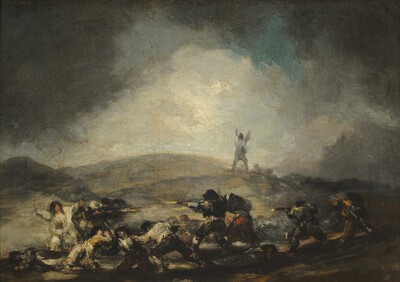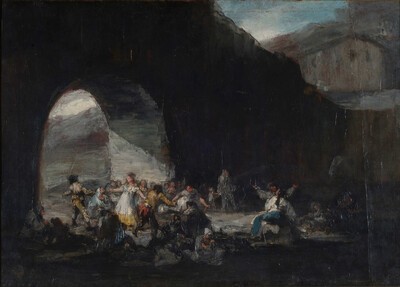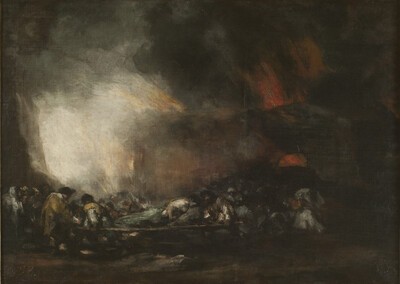- Cronología
- Ca. 1808 - 1812
- Ubicación
- Lost work
- Dimensiones
- 73 x 100 cm
- Técnica y soporte
- Oil on canvas
- Reconocimiento de la autoría de Goya
- Undisputed work
- Titular
- Obra desaparecida
- Ficha: realización/revisión
- 16 May 2010 / 15 Jun 2023
In 1868, Mariano Goya claimed to have seen his grandfather painting this work "with thin reeds, split open at the end".
It was destroyed in the fire at the Buenos Aires Jockey Club in 1956. A reproduction of the work had been made in 1928, together with an indication of its dimensions.
The inscription "X.28" that appears in this painting ties it to three others by Goya which are all mentioned in the inventory made in 1812, following the death of Goya's wife.
A group of figures, painted very sketchily and in very soft tones, can be seen in the centre of the composition, fleeing from the hurricane that is approaching from the back of the scene. The incisions used to depict the violent winds of the hurricane appear to have been made with the edge of a spatula, or perhaps with split reeds, just as Mariano Goya had indicated.
The theme of disaster was a popular one, especially during the second half of the 18th century (see Fire in a Hospital). To a large degree, the way in which Goya handled this theme at the time heralded the arrival of the spirit of Romanticism, which cast serious doubt on the infallibility of enlightened thinking. Disasters, with their ability to upset our sense of order, produce in the human mind an uncontrollable feeling of chaos, provoking both terror and, simultaneously, fascination (see The Fire, The Shipwreck, and Fire in a Hospital).
-
L'œuvre peint de Goya. 4 volsParís1928-1950p. 279, cat. 256
-
Vie et ouvre de Francisco de GoyaParísOffice du livre1970p. 265, cat. 950
-
BarcelonaPolígrafa1970vol. I, pp. 356 y 357, cat. 613
-
L’opera pittorica completa di GoyaMilanRizzoli1974p. 125, cat. 52



